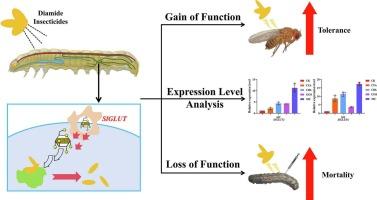揭示斜纹夜蛾马尔比氏小管特异性葡萄糖转运蛋白对异种药物耐受性的功能贡献
IF 4
1区 农林科学
Q2 BIOCHEMISTRY & MOLECULAR BIOLOGY
引用次数: 0
摘要
葡萄糖转运蛋白(GLUTs)是溶质载体(SLC)家族2的成员,在各种生理过程中发挥重要作用。本研究从斜纹夜蛾转录组基因组数据库(ASM270686v3)中鉴定出108个SLC基因,其中以GLUT基因为重点。转录组分析和实时荧光定量PCR (quantitative Real-time PCR, qPCR)结果显示,SlGLUT2和SlGLUT6在马氏小管中特异性表达,且在各种外源药物处理后,其表达量显著增加。通过同源建模和分子对接分析了SlGLUT2和SlGLUT6蛋白的结构特征及其葡萄糖转运特性。此外,SlGLUT2和SlGLUT6在果蝇中的异位表达导致果蝇对二胺类杀虫剂的耐受性显著增加。此外,通过RNA干扰(RNAi)敲低SlGLUT2和SlGLUT6的表达降低了斜纹夜蛾对氰氨酰胺和氯氨酰胺的耐受性。因此,SlGLUT2和SlGLUT6可能在斜纹葡萄的外源耐受性中起重要作用。本文章由计算机程序翻译,如有差异,请以英文原文为准。

Unveiling the functional contribution of Malpighian tubule specific glucose transporters to xenobiotics tolerance in Spodoptera litura
Glucose transporters (GLUTs) are members of the solute carrier (SLC) family 2, which play crucial roles in various physiological processes. In this study, 108 SLC genes were identified from the transcriptomic and Spodoptera litura genome database (ASM270686v3), of which the GLUT genes were the focus. Transcriptome analysis and quantitative Real-time PCR (qPCR) revealed that SlGLUT2 and SlGLUT6 were specifically expressed in Malpighian tubules, and that their expression significantly increased after treatment with various xenobiotics. The structural features of the SlGLUT2 and SlGLUT6 proteins, as well as their glucose transport characteristics, were analyzed using homology modeling and molecular docking. Moreover, the ectopic expression of SlGLUT2 and SlGLUT6 in Drosophila led to a significant increase in the tolerance of the flies to diamide insecticides. Moreover, the knockdown of SlGLUT2 and SlGLUT6 expression through RNA interference (RNAi) decreased the tolerance of S. litura to cyantraniliprole and chlorantraniliprole. Therefore, SlGLUT2 and SlGLUT6 may play important roles in xenobiotic tolerance in S. litura.
求助全文
通过发布文献求助,成功后即可免费获取论文全文。
去求助
来源期刊
CiteScore
7.00
自引率
8.50%
发文量
238
审稿时长
4.2 months
期刊介绍:
Pesticide Biochemistry and Physiology publishes original scientific articles pertaining to the mode of action of plant protection agents such as insecticides, fungicides, herbicides, and similar compounds, including nonlethal pest control agents, biosynthesis of pheromones, hormones, and plant resistance agents. Manuscripts may include a biochemical, physiological, or molecular study for an understanding of comparative toxicology or selective toxicity of both target and nontarget organisms. Particular interest will be given to studies on the molecular biology of pest control, toxicology, and pesticide resistance.
Research Areas Emphasized Include the Biochemistry and Physiology of:
• Comparative toxicity
• Mode of action
• Pathophysiology
• Plant growth regulators
• Resistance
• Other effects of pesticides on both parasites and hosts.

 求助内容:
求助内容: 应助结果提醒方式:
应助结果提醒方式:


